Unmanned robotic complex
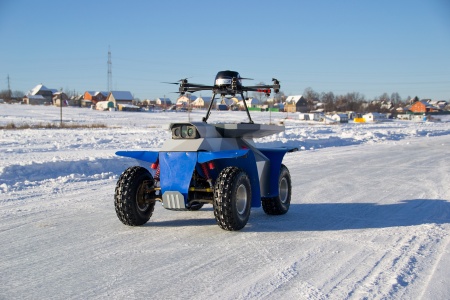
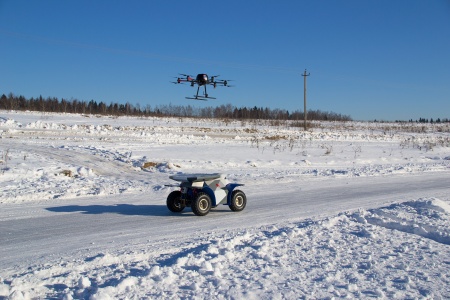
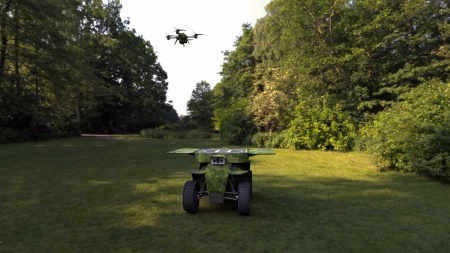
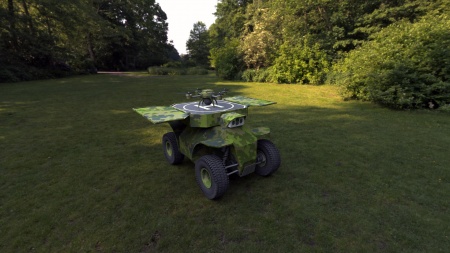
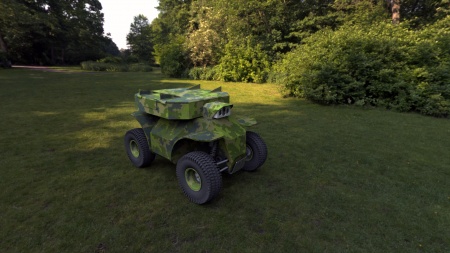
SRX 3 mobile robotic platform is ideally suited to be a UAV carrier (ground robot) in an unmanned robotic complex. A ground robot can deliver an aircraft to a specified location, which allows the UAV not to spend time and power for flying from its home station to a specified area significantly extending its operation range.
Considerable power supply of a ground robot can be effectively used for powering a UAV. The unmanned robotic complex is available in two variants. In the first variant electricity for rotors and a payload is transmitted along a wire from an unmanned ground vehicle. This technique permits an aircraft to stay at a specified height indefinitely long.
In the second variant an unmanned aerial vehicle operates in an autonomous mode; it automatically takes off and lands on a ground vehicle. Unlike the first variant, in which an aircraft hovers over a ground robot, the second variant allows a UAV to fly within a considerable distance from a ground robot. When a flight mission is fulfilled or the batteries are flat a UAV automatically lands on a ground robot and recharges its batteries using the robot’s power generation system. An unmanned robotic complex comprised of a mobile robotic platform and a vertical takeoff and landing UAV has the following applications depending on a payload taken:
Area video surveillance and perimeter surveillance at various heights.
Video cameras fitted to a UAV provide the observation range of a few kilometres. The use of multispectral video cameras with a night vision option ensures 24 hour surveillance and a high degree of distant objects detection. A UAV conducts flights over the specified perimeter in the autonomous mode. For recharging it lands on an unmanned ground vehicle at a location different from its original takeoff. Thus performing perimeter surveillance in hard-to-access areas becomes feasible. Video cameras and a video signal transmitter fitted to UAV allow transmission of video images over a considerable distance. At the flight height of 300 meters a stable connection is available within 35 km range.
Retransmission of wireless communication channels and setting up temporary wireless coverage. A radio retransmitter lifted by a UAV can quickly set up a radio communication network with large coverage. For this purpose it is effective to use a UAV connected to a ground robot. A quadcopter and retransmitter receive electric power along a wire from a petrol-driven generator of a ground robot. This technique allows a UAV to hover over a ground robot indefinitely long. Using an unmanned ground vehicle as a UAV carrier pursues two aims – to provide a UAV with electric power and find the most convenient location for a retransmitter. Ground robot’s high mobility, maneuverability and autonomy give it a considerable advantage over off-road automobiles in the aforesaid mission.
A group of unmanned robotic complexes fitted with retransmitters is capable of setting up a self-organizing MESH network and ensuring its automatic functioning in case some cross-point retransmitters happen to fail. Such group can be delivered to a disaster area by trucks with high terrain-crossing performance. For example, KAMAZ 6560 chassis can carry 6 unmanned robotic complexes with retransmitters.
Night lighting in hard-to-reach places.
A LED floodlight fitted to a UAV is helpful for rescue and search operations and other missions that require lighting. Using a UAV connected to a ground robot makes it possible to keep lighting on for indefinitely long. Radiation control in hazardous areas and sites.
An unmanned robotic complex can be effectively used to distantly measure radiation levels without the risk to an operator. Automatic control systems of the complex allow taking regular measurements in a fully autonomous mode. Highest efficiency of the unmanned robotic complex has been achieved in missions that require systematic and methodical measurement taking. The complex is very cost effective - it allows accurate measurement taking without involvement of operators and vehicles for their transportation.
Wheeled chassis ensures long distance traveling while a UAV reaches areas and facilities that are difficult to access. When measurements are taken the UAV returns to its ground robot to proceed to another place.
For effective operation at high latitudes and in Far North a vertical takeoff and landing UAV is placed into a closed heated container to prevent quick accumulators discharging and ensure swift takeoffs in low temperature environments.
